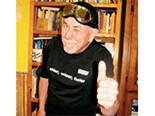Hands-On Diagnostics - Blackbourn 389



|
On the right day, just wearing a different t-shirt can point you down the path to enlightenment - a bit
Fellow Unique Cars scribe Steve Nally said: "I’ve got the book at home, Rob."
My vaguely puzzled expression (some say I always look like that) prompted him to elaborate. My So-Cal Speed Shop t-shirt had caught his eye (you can take the boy out of the hot rod, but…). And Steve was offering to lend me a book about So-Cal.
While my generation of side-whacker Ford V8 tragics in 1960s Australia understood that hot rodding’s golden years kicked off in post-WWII Southern California, we were light on detail. Nally’s book, So-Cal Speed Shop by Mark Christensen, filled in many gaps for me. Exotic speed-equipment brands that we teenage petrol-heads used to drool over in American hot rod mags suddenly became real people. Pioneers like Vic Edelbrock, Phil Weiand, Dean Moon and Clay Smith were part of So-Cal proprietor Alex Xydias’ peer group – my old diesel Hilux ute carries a back window sticker of Clay Smith’s cigar-smoking ’pecker, ‘Mr Horsepower’, as an ironic tribute to those happy, hopeful days.
This passage about Smith got my attention: "The red-haired, wrench turning legend Clay Smith was reputed to be able to ‘tell how well an engine was running by pressing his loins against the body of the car’."
The degree to which this procedure stimulated the legendary cam grinder’s ‘loins’ in a special way was less interesting to me than its example of a pre-electronic, pre-error codes, man-to-machine diagnostic technique. Like many of you I’ve chased exhaust and vacuum leaks using a bit of hose as a stethoscope, and similarly pressed my ear to the handle of a sturdy screwdriver to help pin down a troubling rattle or bearing rumble inside a motor. What I’ve never done is a trick I witnessed in the pits at Melbourne’s long-gone Tracey’s Speedway. Flathead Ford V8 ignition systems were always trouble. One gifted old grease-monkey could diagnose spark issues by grabbing bare spark-plug terminals in turn with one hand while manipulating the throttle with the other. Then came a verdict like: "It’s number two that’s breaking down badly. Number seven’s a bit erratic, too. Check the distributor cap and whack on a couple of new leads."

Okay, with a basic six-volt, points/coil set-up, he wasn’t soaking up the fierce output of modern ignition systems. But it was nevertheless impressive that he managed it without flinching. As well it was way more informative than the old technique of pulling off high-tension leads one at a time to locate a sick cylinder on an idling motor – the one that didn’t make the motor stumble worse when pulled was the crook one.
A variation on that theme won me gratitude and some excellent wine during a stint in England in the 70s. An anxious neighbour, who’d heard that ‘the Aussie’ moonlighted doing car repairs, caught me leaving for work. That winter’s Friday morning their newish Range Rover, fully loaded with family and gear, ready for a skiing weekend in distant Wales, had just started misfiring. I was flummoxed that the idle actually improved when I pulled a particular lead from the distributor cap. Fortunately a look inside the cap explained it – there was a faint arc-track in a hairline surface crack between two adjacent terminals. One pot was cross-firing another pot prematurely, opposing that piston’s rise on compression.
After explaining how to swap leads to a new distributor cap – carefully, one at a time – I sent my new apprentice and his family off to the local dealer’s parts outlet a couple of miles away, fortunately west toward Wales. Necessity had overruled his doubts about my diagnosis and his own under-bonnet abilities.
The wine arrived Monday night.
Unique Cars magazine Value Guides
Sell your car for free right here
Get your monthly fix of news, reviews and stories on the greatest cars and minds in the automotive world.
Subscribe

.jpg)














